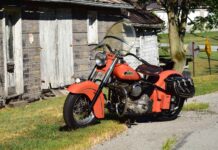
Now and again you’ll still see a nice Harley Duo-Glide from the 1960s ambling down the road, a happy couple in the saddle, powered by the reliable 74-inch Panhead engine. “Best damn motor Harley ever made,” it’s been said more than once.
What you’ll rarely see from that era is a Harley-Davidson Topper motor scooter, built in Milwaukee from 1960 to ’65. Vespas and Lambrettas weren’t widely available in the States back then, and the scooter market was largely owned by Cushman, Salsbury, and, stretching the scooter definition a bit, Mustang.
The Topper was propelled by a 165cc DKW reed-valve two-stroke, rated at 9 horsepower. Harley was awarded the components and tooling from the Germans as spoils of war after WWII. The motor was also used in the Hummer and dual-sport Scat. In the Topper, the belt-driven centrifugal clutch carried a sprocket with chain drive to the rear wheel, and the system was labeled “Scootaway Drive.” Seriously. Starting it was by a lawnmower-style pull starter. A secondary set of points allowed the ignition to be advanced or retarded to ease starting.
At 250 pounds, the Topper was no lightweight and acceleration was never termed brisk, but it could attain a top speed of 46 mph. The floorboard, front leg shield, and fender were steel, with separate springs and shocks on the leading-link front fork. The top of the bench seat was 31 inches off the ground, and the storage bin below included a cubby for a can of pre-mix oil. The Topper tootled on 12-inch wheels with drum brakes.
Since licensing requirements varied widely throughout the States, Harley offered a detuned version of the scooter to cover those areas that restricted use based on power output and/or rider age. The Topper U model held a 5-horsepower rating, so the acceleration was definitely less than brisk. The Cushman Pacemaker and Road Master were roughly equivalent to the Topper in terms of weight and horsepower. Both were also sold by Sears using the Allstate brand.
Both Harley and Cushman went into business in 1903 and had also been direct competitors in the golf-cart market. And, as fate would have it, both companies ceased scooter production in 1965. Their demise arrived in the form of the Honda 50, which begat the 65, 90, 100cc four-strokes, small motorcycles, ostensibly ridden by the nicest people. They rendered the American manufacturing of motor scooters historical.
Mustang built small motorcycles in Glendale, California. Its first model, the 1946 Colt, was powered by a 125cc Villers engine. After acquiring Busy Bee, a manufacturer of small engines, the 1947 Mustang Model 2 was equipped with a 320cc four-stroke Single with a 3-speed transmission, and it was the first American motorcycle to use a telescopic fork. Later models used a 318cc Briggs & Stratton engine, and a race version built and ridden by Walt Fulton was winning flat track races until the AMA instituted new rules mandating the minimum diameter of wheels to be at least 16 inches, reportedly at H-D’s behest. Mustang also suspended production in 1965.
Though Harley was only a player for five years, motor scooters have been part and parcel of the American two-wheeled mix for more than 70 years. Which they, of course, still are, given their obvious usefulness for so many requirements of urban transport. Can’t beat ’em for the quick trip to the store, lunch stop, park, or library. Just twist the throttle and they scoot away.



















Official thr HD “Hummer” was only offered with the 125cc engine. The 165cc model was simply called the “165” which then morphed into the “Super 10” in 1960.